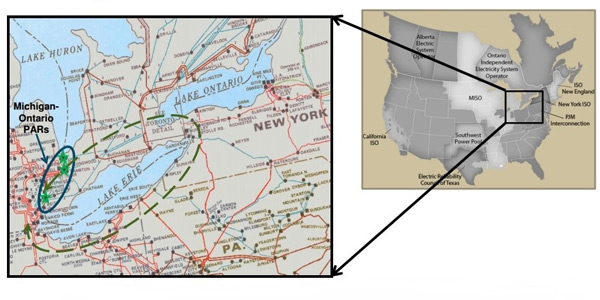By Amanda Durish Cook
A proposal by MISO and ITC Holdings to allocate the costs of phase angle regulating transformers (PARs) to entities outside of MISO is not just and reasonable, FERC ruled last week.
The commission’s Sept. 22 order upheld Administrative Law Judge Steven Sterner’s 2012 decision prohibiting MISO and ITC from allocating the costs of ITC’s two 700-MVA PARs on the Michigan-Ontario border to NYISO and PJM (ER11- 1844-001, ER11-1844-002). The commission also denied as moot requests by several parties for rehearing.
Failure to Show Benefit
FERC said MISO and ITC “failed to show that NYISO or PJM will benefit from the operation of the ITC PARs.” The commission noted that two NYISO and PJM witnesses testified that the two grid operators could “actually be harmed by the planned operation of the ITC PARs.”
“For example, a reduction in counterclockwise loop flow that may benefit MISO might, at the same time, harm NYISO if both transmission systems are experiencing congestion on transmission facilities that are affected by loop flow,” FERC wrote.
MISO and ITC proposed allocating 49.6% of the PARs cost to MISO, 19.5% to PJM and 30.9% to NYISO, based on each region’s contribution to the loop flows that would occur over the Michigan-Ontario interface without the PARs. Unscheduled loop flows around the Lake Erie region have been a problem since the late 1990s.
FERC ordered MISO and ITC to refund, with interest, all amounts collected pursuant to their Oct. 20, 2010, filing in excess of rates in effect prior to Jan. 1, 2011. MISO also has 30 days to revise parts of its Tariff that pertain to the cost allocation of PARs.
Reversal
FERC, however, reversed Sterner’s ruling that MISO and ITC were precluded from unilaterally filing proposed solutions with the commission. “While the commission has made clear its preference that interconnected utilities strive to resolve loop flow-related issues among themselves rather than resort to unilaterally filing proposed solutions with the commission, a public utility is legally permitted to make a unilateral filing to address loop flow,” FERC said.
PJM opposed the PAR cost allocation, saying that ITC’s two PARs replaced a single failed 800-MVA PAR that was “planned, developed and placed into service to meet local system needs.” NYISO objected to paying cost allocation for the ITC PARs because they “were not developed pursuant to a commission-approved regional planning process.”
ITC and MISO’s case for allocating the costs rested on Lake Erie’s loop flows no longer presenting a problem for PJM and NYISO. In a 2014 report, MISO, PJM and Ontario’s Independent Electricity System Operator (IESO) found that all five of the Lake Erie PARs were able to keep actual flows within 200 MW of scheduled flows most of the time.
Plans on Hold
After completing a yearlong observation of the ITC PARs and three other PARs at the Michigan-Ontario border in 2013, PJM and MISO incorporated the PARs into their market-to-market process on July 28. For now, PJM has put on hold plans to use the PARs for congestion management.




